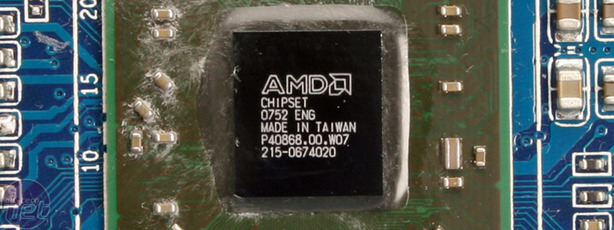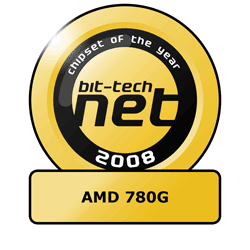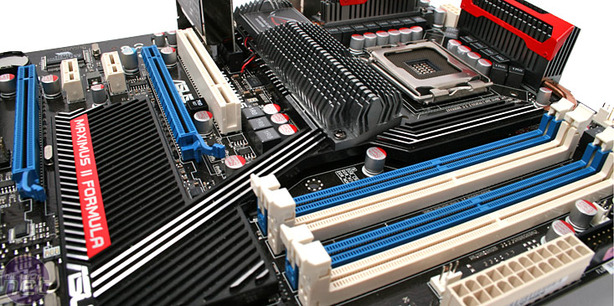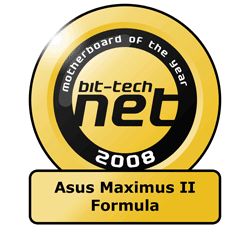
Best Chipset: AMD 780G
Notable Mentions: Intel P45, Nvidia GeForce 8200.After many, many years of painfully slow and under performing integrated graphics chipsets, in March this year AMD beat everyone else to the punch with its monster of an IGP - the 780G.
While the SB700 southbridge was far better than the old SB600, it was far from "right" - but that didn't matter because AMD was the first to market with a chipset you could really game on (basically) and as importantly - it had the great UVD engine to accelerate HD video.
We found we could build a Blu-ray capable system for less than a basic PS3, and with far inherent more choice for expansion. Coupled with the new 45W dual core Athlon 4850e CPU, AMD had very affordable, extremely low power, yet fully capable system for a variety of applications.

Runner up is Intel's P45 chipset - the last performance-mainstream chipset with a front side bus. Launching Intel's 65nm chipsets, it was a bit cooler than the P35, didn't need as much voltage and it also hit even higher front side bus overclocks - Biostar and DFI often nosing into 600-700+ ranges for extreme overclockers.

While the X48 started it, with P45 Intel opened up even more tweaking and overclocking options to eke out the last shreds of performance from its old architecture in the form of MCH tRD, more GTLs, Clock Skews and Clock Driving currents.
We're already into the second round of P45 boards to hit the streets and they've made a staple diet of purchases for performance enthusiasts for the last six months and will continue to do so well into next year too.
Finally, Nvidia's GeForce 8200 for AMD CPUs is also as noteworthy as AMD's 780G, but it was several months later to the integrated graphics party. While the GeForce 9300/9400 for Intel CPUs has even bigger potential, the chipset was way too late with a BIOS and featureset that just didn't work properly.
The GeForce 8200 on the other hand works as well as AMD's 780G, but as a single chip MCP it takes up less space and the SATA and USB performance is generally better too.
Best Motherboard: Asus Maximus II Formula
Notable Mentions: DFI LANParty LT X48 T2R, Asus P6T Deluxe, Gigabyte GA-EP45-UD3R, J&W MINIX 780G mini-ITXWe rarely give excellence awards to motherboards, mostly because the market is so incredibly intense and rarely do well featured, fantastically adept motherboards not command the appropriate, liberal price tag. The Asus Maximus II Formula went against this trend - it looks fantastic, worked incredibly well, and it had a price that wasn't outside of a sensible performance-enthusiast budget so it takes away our top award.

That's not to say we haven't seen a lot of great boards this year - Gigabyte has been ravenously on the heels of Asus all year and for those on a tighter budget the GA-EP45-UD3R fits the bill perfectly.
 As much as we're hesitant about Gigabyte's "2oz of copper is notably better" claims, the other great features and superb performance score it very highly indeed.
As much as we're hesitant about Gigabyte's "2oz of copper is notably better" claims, the other great features and superb performance score it very highly indeed.While we've not looked at even a small fraction of the X58 boards we've got in the office yet, the Asus P6T Deluxe is our current favourite partner for Intel's new Core i7 CPUs at the other end of the scale. Like the Gigabyte, it's not perfect, but it has it where it's needed - performance, price, overclocking and core features that count.
Finally, we couldn't say the 780G is our chipset of the year without suggesting a motherboard based on it and our last notable mention is the J&W MINIX 780G mini-ITX motherboard.
J&W created the tiniest little monster we've seen to date - accepting a 65W CPU, dual channel memory and even a PCI-Express x16 card for your gaming pleasure. It's got more bits in just a 17cm square space than we could actually conceive and still have no idea how J&W did it. It's been the ultimate HTPC SFF board this year without a doubt.

MSI MPG Velox 100R Chassis Review
October 14 2021 | 15:04








Want to comment? Please log in.